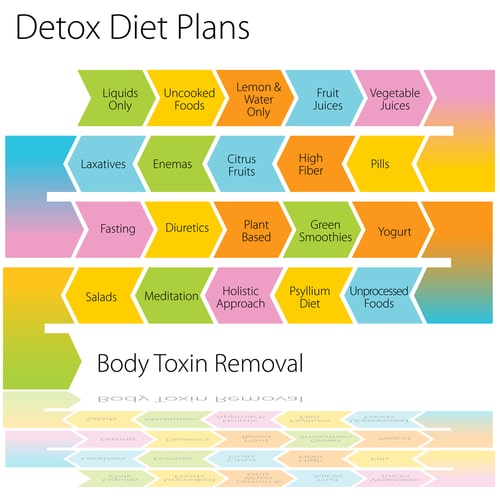
What is Detoxification?
In medical terms, detoxification is the conversion of fat-soluble toxins to water-soluble ones that can be more readily eliminated through urine or bowel movements. The organ that’s most important for breaking down toxins is the liver. Supporting liver health and ensuring that the enzymes involved in breaking down toxins can function is a way to help the liver do its job of detoxifying.
Unfortunately, detox diets like the Master Cleanse do nothing to increase the liver’s ability to break down toxins. This popular “cleansing” diet recommends drinking a concoction of lemon juice, maple syrup and cayenne pepper for up to 10 days. You might lose weight on such an extreme regimen, but you’ll likely regain it once you go off the diet – not to mention the nutritional deficiencies and muscle breakdown you’ll get from lack of adequate protein, carbs, and nutrition in general.
The Healthy Way to Detoxify
Your liver has two groups of enzymes called phase 1 enzymes and phase 2 enzymes that transform fat-soluble toxins into ones your body can eliminate. Phase 1 enzymes process a potential toxin first and then pass it to the phase 2 enzymes to finish things off. With these two steps, the liver changes a toxin into a form that can pass out of the body. The key is to make sure these enzymes can do their job and that they remain in balance. Phase 1 enzymes create unstable intermediates and free radicals that are stabilized by the phase 2 enzymes.
If phase 1 enzymes are working properly but the phase 2 enzymes are lagging behind, the unstable compounds produced in the first step can damage cells. There are also phase 3 enzymes that transfer detoxified compounds out of cells and into the bloodstream so they can be eliminated.
Certain dietary components enhance the activity of detoxifying enzymes made by the liver. Adding more of these foods to your diet is a safe and natural way to help your body remove unhealthy toxins that can damage cells and lead to health problems or premature aging. Instead of maple syrup and lemon juice, eat more of these types of foods to help your liver remove toxins:
Cruciferous vegetables
Broccoli, kale, and cabbage help your liver process toxins. Compounds in cruciferous vegetables increase the activity of phase 1 and phase 2 enzymes in a balanced way. The ability of cruciferous vegetables to enhance the activity of these enzymes accounts for some of their cancer-protective benefits.
Fruits and Vegetables
Cruciferous vegetables are in a class by themselves when it comes to helping the liver detoxify, but all fruits and vegetables have natural phytochemicals that help the liver detoxify. Watercress, a cruciferous vegetable, maybe a particularly worthy addition to a detox diet. One study showed that individuals who ate a bowl of watercress each day for 2 months had blood cells that were more resistant to DNA damage that could lead to health problems like cancer. Enjoy this crisp, spicy veggie raw. Unfortunately, cooking destroys some of its anti-cancer benefits.
Fiber
Eating a high fiber diet consisting of both soluble and insoluble fiber helps them liver remove toxins that enter through your digestive tract. Fiber binds to toxins so they can be eliminated through the stool rather than enter the bloodstream. Fruits, vegetables and whole grain foods are all good sources of soluble and insoluble fiber that help your intestines get rid of toxins.
Probiotics
Bad bacteria that live in your intestines produce unhealthy toxins. Eating more probiotic-rich foods like yogurt with active cultures crowds out the bad bacteria and replaces them with bacteria that do good things for your intestines and immune system. In addition to yogurt, fermented foods like sauerkraut, kimchee, tempeh, and kefir are good sources of probiotics.
Green Tea
Lighten up on the coffee and sip green tea for a change. Research shows that the polyphenols in green tea activate liver enzymes that break down toxins. In fact, one study showed they can convert known cancer-causing toxins into harmless compounds. That sounds like a good reason to put a pot of green tea on the stove.
The Bottom Line?
If you’re going to detox, do it the right way. Skip the maple syrup and lemon juice and put more fruits, vegetables and green tea on the table. It’s safer, more effective – and backed by science.
References:
Medical News Today. “Watercress: Anti-Cancer Superfood”
Science Daily. “Green Tea Boosts Production of Detox Enzymes, Rendering Cancerous Chemicals Harmless”
Integ. Cancer Ther. 2004 Mar; 3(1): 5-12.
Related Articles By Cathe:
Why Most of the Things You’ve Heard about Detoxifying Are All Wrong

